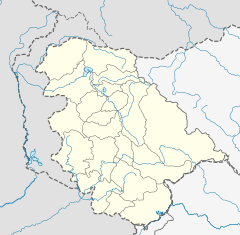Jwala Ji Temple (Kashmiri: जवाला जी मन्दिर (Devanagari)) or Jwalamukhi Temple (Kashmiri: ज्वालामुखी मन्दिर (Devanagari)) is Hindu shrine in the town of Khrew in the Pulwama district of Jammu and Kashmir, India.[3][4]
| Jwala Ji Temple | |
|---|---|
जवाला जी मन्दिर | |
 Jwala Ji Mandir | |
| Religion | |
| Affiliation | Hinduism |
| District | Pulwama |
| Deity | Jwala Ji |
| Festival | Jwala Mukhi Mela |
| Location | |
| Location | Khrew |
| State | Jammu and Kashmir |
| Country | India |
| Geographic coordinates | 34°01′18.2″N 74°59′41.6″E / 34.021722°N 74.994889°E[1] |
| Elevation | 1,607 m (5,272 ft)[2] |
The temple is dedicated to the deity Jwala Ji, the Kul Devi of many Kashmiri Hindu families.[2]
Every year in the month of Ashadha, the Jwalamukhi Fair is held at the mandir; it exemplifies communal harmony common to the tradition of Kashmiriyat, with both Kashmiri Hindus and Kashmiri Muslim celebrating the festival.[5]
History
editThe historian Kalhana refers to the village "Khrew" in the Rajatarangini as "Khaduvi" and writes of three hundred and sixty freshwater springs being present there.[2] According to Kalhana, at the hillside to the east of the village, a mystical diagram was drawn on a rock.[2]
Construction
editThe construction of the Jwal Ji temple dates back to the twentieth century, commissioned by Raja Daya Krishna Kaul. Legend has it that before the temple was built, the divine presence of Jwala Devi appeared as a radiant light (Jyoti) at this sacred site. The story goes that the gods were on a quest to seize Kubera's treasure, but the demons tried to stop them. Upon the deities' request, Jwala Devi intervened and halted the gods' journey at this location. In response to the plea of the deities, Jwala Devi decided to reside permanently at this place, leading to the establishment of the revered Jwal Ji temple.[6]
Holy Spring
editAt the base of the hill, the shrine has a holy spring locally called Bod Nag, Aneek Nag, Anu Nag, or Nagabal.[2] It is customary for pilgrims to perform ablutions with the water of the holy spring before entering the temple.[2][7]
See also
editReferences
edit- ^ India, Geological Survey of (1962). Records of the Geological Survey of India. Geological Survey of India. p. 80.
Towards N. 65° E. of Jwalamukhi temple at Khrew ( 34°01': 75°00'; 43 J / 16 ) also, there are outcrops of limestone with CaO, 49 per cent.
- ^ a b c d e f Bhat, Chander M. (6 December 2014). "The Shrine of Jawalaji Khrew". Daily Excelsior. Retrieved 10 November 2020.
- ^ "Kashmiri Pandits Demand Rebuilding of Jawala Ji Temple". Outlook. 15 December 2014.
- ^ Khan, M Aamir x (30 July 2020). "Gutted last year, temple comes alive with rush of devotees". The Tribune. Retrieved 10 November 2020.
- ^ Sajnani, Manohar (2001). Encyclopaedia of Tourism Resources in India. Gyan Publishing House. p. 163. ISBN 978-81-7835-017-2.
An important festival is Jwalamukhi fair which is held in village Khrew near Pulwama. The temple is situated on top of a small hillock and is known as Jwalamukhi. The festival falls on or about 16th July and is celebrated by Hindus as well as Muslims. About 250 to 300 stalls are set up by Muslim peasants for the sale of different kinds of commodities. Confectionary shops and such other stalls in which earthen trays with ghee and a cotton wick are available for sale are run by Hindu shopkeepers.
- ^ "Jawala Bhagwati Temple, Khrew, Pulwama, Jammu & Kashmir | Famous temple of Jammu Kashmir | Timings | How to reach".
- ^ Fotedar, S. N. (1976). Bhagawan Gopinath Ji of Kashmir: A Biographical Study. Bhagwan Gopinath Ji Trust. p. 17.
Jwala Mukhi Shrine at Khrew. The Shrine is situated 16 miles south - east of Srinagar with a spring where people bathe, and a temple on a hillock.
